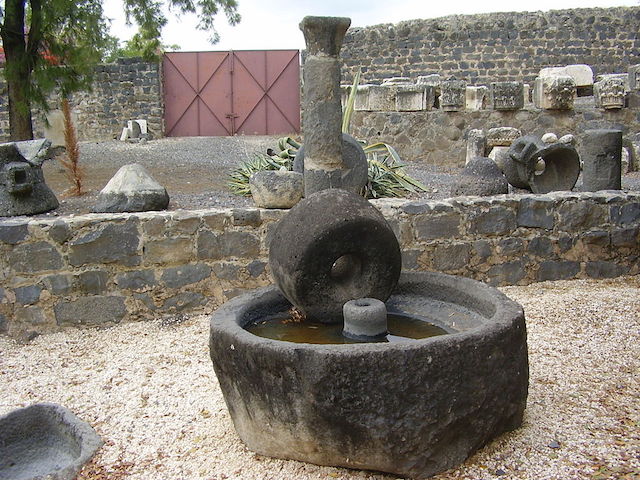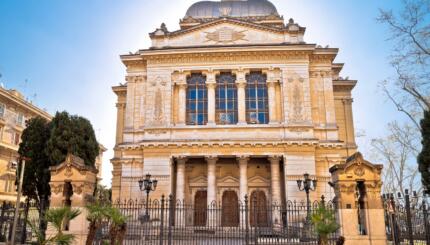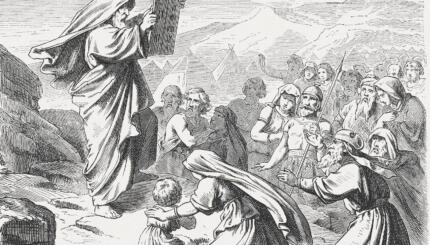Jews living in Palestine in the early centuries of the Christian Era remained as they had been before the destruction of the Temple: an agrarian society. The process of urbanization of the Near East during the Roman and Byzantine periods only affected the Jewish population slightly. Although quite a few Jews resided in towns — Tiberias, Sepphoris, Ceasarea, Lydda — which were even accorded legal urban status by the Roman authorities, the great majority were still living in modest-sized settlements of about 2,000-5,000 people, which Jewish sources describe as “villages.” In the Byzantine period, most of these communities were to be found in the Galilee and on the Golan, but there were some in the Hebron area in the south, and a few along the coastal plain and in the Judean valley.
Thus, the Palestinian economy in talmudic times remained much the same as it had been in the Second Temple period, and could still be portrayed through the words of a second century BCE author:
“Their love for tilling the soil is truly great. The country is plentifully wooded with numerous olive trees and rich in cereals and vegetables, and also in vines and honey. Date palms and other fruit trees are beyond reckoning among them. And for cattle of all kinds there is pasture in abundance” (Letter of Aristeas, 112).
The large number of presses found by archaeologists almost everywhere confirms the existence of flourishing wine and oil industries (the latter being used for cooking, for illumination and for skin lubrication). Fishing was an important industry in the northern part of the country. Crafts, however, were primarily an urban occupation. Jerusalem was apparently well known for the number and quality of its artisans. As more and more Jews moved to the coast they began to engage in regional commerce. During this time many Jews in the north traded with port towns in Lebanon and Syria […]
Patterns of Community Organization
Patterns of community organization began to form in the Second Temple Period. The Book of Judith, probably composed in the Hellenistic period (or even in the late Persian period), describes the communities as governed by archons who received their instructions from the central authorities in Jerusalem. According to Josephus Flavius, each village was administered by a group of seven judges. Josephus himself, appointed commander of the Galilee with the commencement of the Great Revolt, took these legal-administrative units in the region under his charge. It is possible that these convocations of seven judges provided the bases for the institution of the “seven town elders” mentioned in the talmudic period.
As the official representatives of the local community, they were empowered to buy and sell public property, including the synagogue. Both literary sources and archaeological findings refer to the leader of the local community as archisynagogos. It is still unclear whether he [or she] was actually the leader of the entire community or simply one of the synagogue directors, or perhaps in certain places these two functions were one and the same.
Citizenship and Taxes
From the Talmud we also learn about the crystallization of a notion of “citizenship” among the Palestinian Jews: a distinction between permanent and transient inhabitants. The concept has even received legal formulation:
“How long should one be in a town to be as the townsmen? Twelve months. And he who buys a house to dwell in, immediately becomes as the townsmen” (Bava Batra, 1:5).
Even before completing a period of one‑year’s residence, the newcomer had to partake in certain obligations. After three months he was required to contribute to the communal charity fund; after twelve months he became a tax‑paying citizen. Taxes were levied by the community in order to finance the construction of synagogues, buying Torah scrolls, maintaining public property, and paying the salaries of town officials. Among the latter were the agronomos (market inspector), the hazzan (in the Talmudic period designating a synagogue officer, not a cantor), “city guards” (in charge of security but also of observance of municipal regulations such as opening hours of shops), and, finally, schoolteachers.
Education
There is very little information about formal education prior to the destruction of the Temple, although later sources ascribe pedagogical programs to major figures of the Hasmonean years (Simeon ben Shetah) or of the close of the Second Temple period (Joshua ben Gamla).
For the talmudic period, however, there is definite evidence of the existence of permanent institutions for elementary religious instruction – – mostly for teaching children how to read the Scriptures. These were very different from the Greco‑Roman schools which primed adolescents for public careers. The young Jew, who in most cases would earn his living within the family circle, acquired the skill of reading (and sometimes, though not always, of writing), with the “teacher of infants.” Only the very talented or affluent would advance to the study of the halakha [Jewish law] with a renowned master.
The entire educational system, needless to say, was designed only for boys. Although there are indications that some girls did receive a smattering of letters, public activity was reserved for men. Even if women went to the synagogue and heard the sermons, their role remained purely passive. Nonetheless, there was still no “women’s gallery”; the segregation of the sexes in the synagogue was apparently not introduced until the early Middle Ages.
Leadership
Another obscure matter is the extent of intervention of the central authorities in the daily life of the local community. All we know is that in Jerusalem the president (nasi) of the Sanhedrin and his “government” proclaimed the calendar, sometimes sent a commission to investigate the quality of teaching in the towns, and occasionally appointed a teacher or a spiritual leader when a community requested such assistance. One important institution was still absent in the talmudic period: the “town rabbi,” spiritual guide and pastor, respected by all and supported by public funds. This type of local leadership was to emerge only in later generations in diaspora communities.
Reprinted with permission from A Historical Atlas of the Jewish People edited by Eli Barnavi and published by Schocken Books.
Torah
Pronunced: TORE-uh, Origin: Hebrew, the Five Books of Moses.



